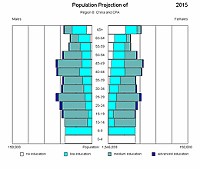Technical Overview
Research Background
In this study we apply the demographic methodology of multi-state population projection to the task. This method is based on a multi-dimensional expansion of the life table (increment-decrement tables) and of the cohort-component projection method, developed at IIASA during the 1970s.
The approach and results appeared in 2001 in Population and Development Review (Lutz and Goujon 2001). Population projections by level of education are a logical next step to improving population forecasts and to make them more relevant.
As discussed in Lutz et al. (1999), adding education to age and sex as an explicitly considered demographic dimension in population forecasting also effects the demographic output parameters themselves because a significant source of so far unobserved heterogeneity is observed and endogenized explicitly. Therefore, it may be considered an improvement even of the purely demographic output parameters of the projection. More importantly, however, the overriding substantive importance of education means that the future educational composition of the population is of interest in its own right.
Educational categories
The specific structure of the multi-state model chosen for this study can be seen in the figure. The educational projections presented here are based on the basic assumptions of the demographic projections developed by Lutz et al. (2001). The fertility, mortality, and migration assumptions follow the median paths of their uncertainty distributions. In addition, three alternative educational scenarios are defined on the basis of different sets of transition rates between educational groups.
The research subdivides the population into four distinct groups according to educational attainment.
- No education: Applies to those who have completed less than one year of formal schooling.
- Primary education: Includes all those who have completed at least one year of education at the first level (primary), but who did not go on to second-level studies.
- Secondary education: Consists of those who moved to the second level of education, whether or not they completed the full course, but who did not proceed to studies at the tertiary level.
- Tertiary education: Anyone who undertook third-level studies, whether or not they completed the full course.
- For a more detailed description about estimating the starting year parameters and the assumptions, please refer to Lutz and Goujon (2001) and Goujon and Lutz (2004).
Each subpopulation is further stratified by age (five-year age groups) and sex, and can be represented through a separate population pyramid.
Key parameters
The key parameters of the model are three sets of age- and sex-specific educational transition rates,namely, the age-specific intensities for young men or women to move, for example, from the category of primary educational attainment to that of secondary attainment. Another important feature that gives this model a dynamic element is the fact that it considers different fertility rates for different educational groups. Migration and mortality are only considered by age and sex in this application.
Modeling information
- The description of the three scenarios used for the projections
- The assumptions by region, scenario, year, and education category by demographic indicators; and the results by 5-year age groups and by 5-year steps of the projection period 2000-2030 for the three above-mentioned alternative scenarios as downloadable Excel (*.xls) or Comma delimited (*.csv) spreadsheets.
- Results file (Excel format or Comma delimited format) of the age-specific population for the three above-mentioned alternative scenarios by region and for the world. Numbers are presented in thousands.
- Results of the human capital projections by the ICDP scenario of the 13 IIASA world regions, presented as population pyramids.



